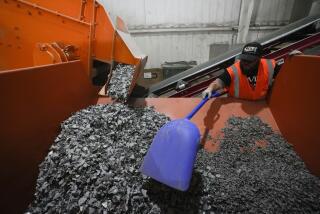Science / Medicine : Solar Flexes : Energy: Pliable photovoltaic cells that use low-grade silicon may finally bring sun-based power to an economically competitive price.
- Share via
“Electric sandpaper” is what one of its inventors calls it.
And it may be an answer to the long-sought goal of producing solar power at a realistic cost to the consumer.
The inexpensive, fabric-like photovoltaic material shown off recently by Southern California Edison Co. and Texas Instruments Inc. is a promising surprise from an unexpected line of research.
Most companies trying to cut the cost of photovoltaic cells, or solar cells, have concentrated either on refinement of the original silicon technology or trimming their use of expensive photovoltaic material by applying it as a thin film.
The new solar material “is different in kind from anything that has ever been done before,” says Gary L. Jones, manager for photovoltaic projects at Sandia National Laboratories, in Albuquerque, N.M., an independent lab operated for the U.S. Department of Energy.
“This is the biggest breakthrough that photovoltaics has ever had,” says Richard Curry of Photovoltaic Insider’s Report, a Dallas-based newsletter.
Breakthrough isn’t a term that Jones likes to apply to advances in photovoltaic research. “Solar does not need a breakthrough,” he says. “It needs some good engineering.”
Still, “it’s a breakthrough in a manufacturing sense,” Jones says. “It looks like it has a lot of potential in its use of low-cost materials and it may have a lot of potential in automated fabrication techniques and high (efficiency) use of the materials.”
Photovoltaic cells are made from silicon processed to create two areas in the cell: one with an excess of electrons; the other, a deficit. When sunlight hits the cell, exciting the electrons, they move between the regions, creating an electric current. Albert Einstein won a Nobel prize for explaining this effect, which had first been noticed in 1839.
Conventional solar cells are five-inch round wafers sawed from yard-long, cylindrical ingots of highly refined silicon. It is a relatively expensive process, in part because 30% to 50% of the silicon is lost as sawdust, Jones says. Yet over the last three decades, since the first practical solar cells were developed, improvements in manufacturing efficiency and new ways of treating the silicon have dramatically lowered costs and brought the devices into fairly common use in hand-held calculators, outdoor lighting, freeway call boxes and for electric power in remote locations.
Recently, much research has centered on thin-film technology, currently used in few commercial applications. This technique spreads fine layers of various photovoltaic materials on a rigid base layer.
The world’s largest producer of photovoltaics, Siemens Solar Industries of Camarillo, has so far focused on improvements to the conventional technology, reducing costs by incremental improvements in manufacturing and in the energy-generating capacity of its cells. In the longer term, Siemens expects thin-film technology to be “the best opportunity for the future,” says Chris Eberspacher, senior director of research and development.
The other big U.S. photovoltaic manufacturer, Solarex Corp. of Rockville, Md., has concentrated its research on thin films, primarily by vaporizing photovoltaic materials and laying them down on glass, a process the company believes can be highly automated in the future.
The Texas Instruments-Edison technology is quite different. Instead of sliced photovoltaic cells in the familiar rigid matrix of a solar panel, electricity is produced by tiny spheres set in a flexible foil.
But Jules D. Levine, who is in charge of technology development on the project, said, “the breakthrough was in selecting a feedstock material that is inexpensive and in unlimited supply.”
The new process takes low-quality, metallurgical-grade silicon and refines it to a purer state while turning it into tiny spheres--like BB shot--each with the ability to generate a minute electric current.
In a simple and inexpensive procedure, the spheres are embedded in a mesh screen formed from a thick aluminum foil that is not so different from the foil used to wrap one’s Thanksgiving turkey, according to a Texas Instruments spokesman. Metallurgical-grade silicon costs just $1 to $2 a pound, compared with $10 or more a pound for solar grade, which is rejected material from $75-a-pound high-purity silicon used in semiconductor chips and circuits.
Though the rejected material does not meet the purity standards for chips, it is fine--albeit expensive--for photovoltaic cells.
“TI has always believed we shouldn’t base a business on a reject material from another process,” Levine said, “because if this really takes off, we don’t want to be dependent on that.”
The flexible final product--so flexible it can be lightly folded--has about the same electricity generating capacity as an equal surface of conventional cells. Flexibility is an important plus, proponents say, because conventional rigid cells are brittle and easily broken.
Beyond this, each of the new four-inch-square solar cells contains 17,000 individual spheres. Because each sphere operates independently, damage to part of the material’s surface does not bring a complete power shutdown, as it does in conventional five-inch cells. This cuts waste in manufacturing and makes the new cells more durable in the field, say its inventors.
All this could drop the cost of solar electricity significantly.
The first solar cells, developed to power satellites, were extremely expensive compared with other methods of producing electricity, at least on the ground. The cells cost roughly $1,000 per watt of electricity-generating capacity.
That has dropped over the years to a current retail price for conventional solar cells of $5 and $8 a watt, or $8 to $15, including the device to convert the solar cells’ direct current to standard household alternating current.
Most industry observers and government researchers have estimated that prices would have to fall to $1 to $2 a watt for a complete system to bring photovoltaic energy into widespread use.
Edison and Texas Instruments hope to market their new solar panels at from $1.50 to $2 a watt, or less, including the converter.
Though Edison sees potential within a few years of cutting peak-hour demand on its system, particularly on summer afternoons when people crank up their air conditioners, that low price would bring solar into the economic ballpark with coal and other big power plant fuels.
“A dollar a watt would certainly be providing electricity competitive with other sources of electricity,” said Larry Sherwood, executive director of the American Solar Energy Society, based in Boulder, Colo. “That would bring solar to average people.”
In the short term, Edison expects its first application in demonstration projects with other utilities--and if successful, on rooftops for peak-load use in Southern California.
Such a system would allow homeowners to tie into the Edison electrical grid, generating power automatically from their rooftop panels when the sun was shining. But being tied into the regular power lines, homeowners wouldn’t have to store that electricity in batteries for later use.
Edison estimates that the average Southern California household’s annual need for 6,000 kilowatts of electricity could be cut by one-third to one-half using this technology. Edison, in turn, would avoid building at least some of the power plants that population increases and electricity demand might otherwise require.
But Texas Instruments is only beginning to consider what could be a wide range of future applications.
Meanwhile, Jones of the Sandia lab and others caution that while the new technology is extremely promising, the other solar research avenues will likely have their uses too.
“This isn’t going to be a one-horse race,” Jones said. “We think there are a number of systems that could meet that $1 to $2 price. . . . The TI process is one of the paths, if everything works the way they hope it works.”





